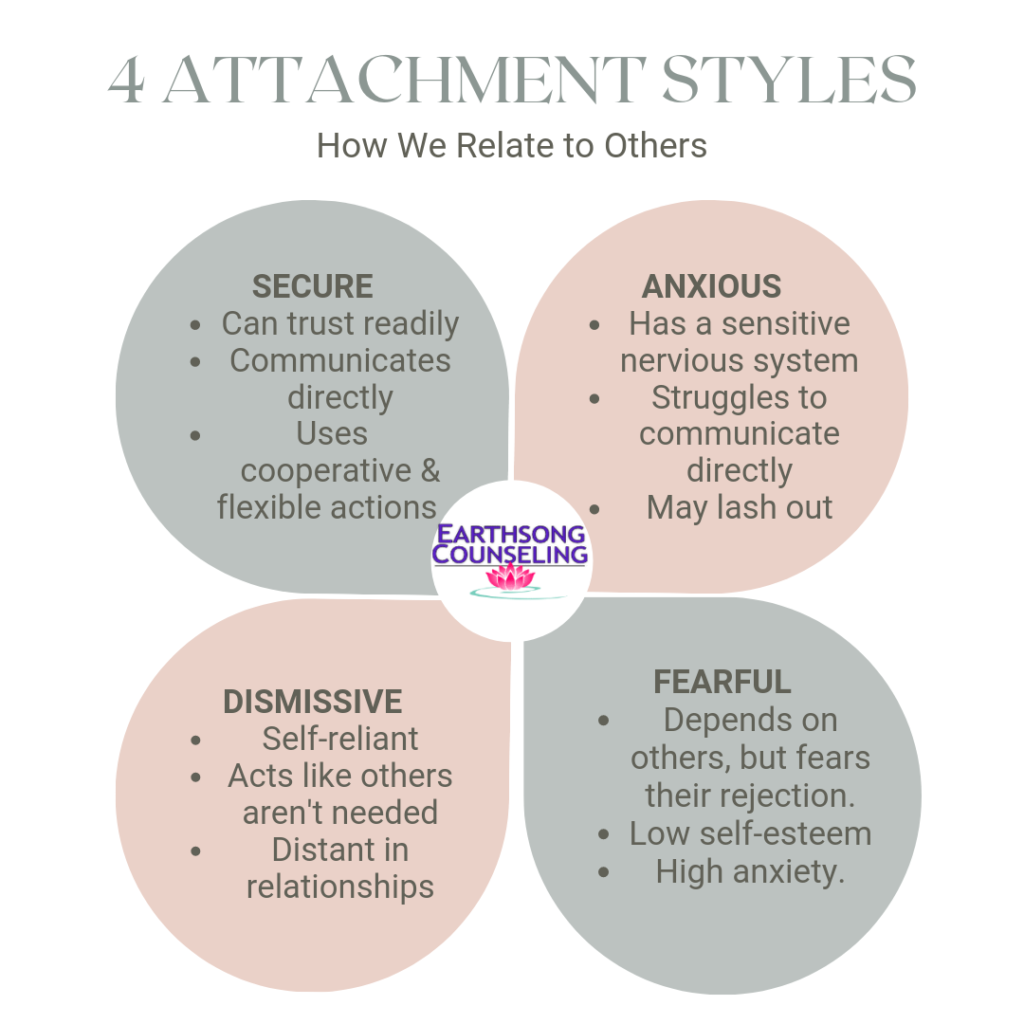As human beings, we all have connections with others. The way we form these connections can be viewed as our attachment type. While one person may be able to readily make friendships and build trust, another person may keep people at arms length and not really rely on anyone. In the course of researching attachment, social scientists discovered there are four basic attachment types.
Four Attachment Types
As mentioned, there are four basic styles of attachment. In addition, these 4 styles also fall into other categories, such as healthy vs unhealthy or secure vs insecure. Here, we explore each of these styles and the characteristics of each. We also explore how these types “show up” in the therapy relationship.
Secure Attachment
Secure attachment is the healthiest of the attachment types. If you fall under this attachment style, you are able to develop trust fairly easily, when its appropriate. You are also able to identify and communicate about your own feelings without experiencing too much discomfort. You are comfortable in your relationships and do not fear rejection or abandonment.
In a therapy relationship, if you have a secure attachment style you likely find the beginning stages of therapy much easier than other clients. You find it easier to build a relationship with your therapist and easier to trust your therapist overall. You find it fairly easy to advocate for yourself, and you are okay with telling your therapist when things aren’t going well.
Anxious Attachment
Anxious attachment is a form of insecure attachment. If you have an anxious attachment style you are likely more sensitive than other people. You don’t avoid relationships with others, but you do experience a high amount of anxiety while in them. You have difficulty communicating your needs and tend to lash out when your needs aren’t getting met.
In therapy, you may feel more anxious about sharing things in the therapy relationship or addressing concerns with the therapist. For example, you may have more trouble addressing hurtful comments or problem behaviors by the therapist. You might worry about saying the “wrong thing” and losing the “care” of your therapist. You also don’t avoid having a relationship with your therapist, and it is a little easier for you to rely on your therapist for support when needed.
Dismissive Attachment
Dismissive attachment is a form of insecure attachment. It also falls into the category of avoidant attachment. That is, if this is your attachment style, you avoid relationships with others for the most part. In your relationships, you are distant. You rely on yourself and don’t really need the help of anyone else. You protect yourself from rejection and abandonment by avoiding relationships entirely.
Therapy is likely going to be more difficult for you if you have a dismissive style. Therapists who don’t understand attachment are likely to call you “resistant” or discharge you because you’re “not ready.” You might have a hard time trusting a therapist. And you might find that you leave therapy at the first sign of getting close to a therapist.
Fearful Attachment
The final type of attachment is fearful. If your relationships tend to follow the fearful attachment style, you most likely experience more anxiety in relationships. Your relationships tend to be either hot or cold. You get really close to someone, but when you get afraid that they’ll abandon you or reject you, you push them away.
In a therapy relationship, you will likely have the same type of off and on relationship. It’s likely that you will fire your therapist at some point during therapy. You will probably have times that you feel really connected with your therapist and other times when you feel really betrayed by her.

Causes of Insecure Attachment
Children learn to create secure attachment when their caregivers are responsive and attend to their needs. On the flip side, children can learn at a very young age that relationships are not safe and trusting people isn’t okay. Adverse childhood events, or ACEs, can contribute hugely to these insecure attachments. You can also develop insecure attachment after experiences in your teenage years or adulthood, such as significant difficulties with friends, domestic abuse, or any other experience which shakes the foundation of how you understand and interact in relationships.
Insecure Attachment in the Therapy Room
Insecure attachment is a frequent visitor in therapy. These patterns of behavior don’t just go away when you get a therapist. Instead, they also become evident in the relationship between you and your therapist. You might find that you feel the need to push your therapist away because you’re getting too close. Or you might find that it’s difficult for you to really feel you can trust your therapist. You might even find that when something happens between you and your therapist, you feel tempted to ghost your therapist rather than stay and work on it.
It is normal to have questions about whether your therapist really cares about you. And the therapy relationship is unique because it is simultaneously a transactional relationship based on the exchange of money and a relationship in which you expect empathy and compassion. It is also normal to want to protect yourself as you navigate the therapy relationship, whether its protecting yourself from getting too close, protecting yourself from when things go wrong, or any other form of protection.
Healing Insecure Attachments Types
Identifying how your insecure attachment shows up in therapy is a good opportunity for you to begin to heal. As you learn to handle different things with your therapist, you can apply those things to other relationships. For example, learning to trust your therapist can help you to trust other people in your life. Learning to resolve disagreements with your therapist can help you resolve disagreements with others also. These successful experiences and the creation of a secure attachment with your therapist are important parts of your healing.
It can also be helpful to process specific trauma experiences which have led to the development of your insecure attachments. This can be accomplished by any type of trauma therapy, whether it’s EMDR, cognitive processing, narrative therapy, or anything else. In this sense, therapy serves the dual purpose of helping with this processing and helping you establish new, positive memories of a healthy relationship.





